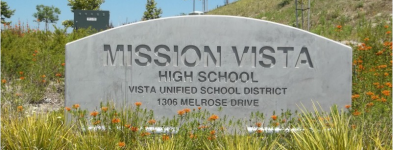 EH&A has helped districts to plan and construct numerous facility projects. One of the most challenging was Vista Unified’s Mission Vista High School. We invited Mike Vail, Vista Unified’s former Assistant Superintendent of Facilities and External Relations, to recount the project’s history–and to report on the recognition it has recently received for its outstanding magnet programs. Mike and I are both Past Chairs of C.A.S.H. and have served together on its Board of Directors for many years. The first Chair of C.A.S.H.’s Outreach Committee and Urban Schools Committee, Mike was also the first President of Californians for School Facilities, a statewide lobbying organization that advocates for Federal school facility financing assistance. During this year’s C.A.S.H. Annual Conference, Mike was recognized for the many fundraisers he organized in support of the successful Proposition 51 campaign. He currently serves as a Senior Advisor at NAC Architecture.
EH&A has helped districts to plan and construct numerous facility projects. One of the most challenging was Vista Unified’s Mission Vista High School. We invited Mike Vail, Vista Unified’s former Assistant Superintendent of Facilities and External Relations, to recount the project’s history–and to report on the recognition it has recently received for its outstanding magnet programs. Mike and I are both Past Chairs of C.A.S.H. and have served together on its Board of Directors for many years. The first Chair of C.A.S.H.’s Outreach Committee and Urban Schools Committee, Mike was also the first President of Californians for School Facilities, a statewide lobbying organization that advocates for Federal school facility financing assistance. During this year’s C.A.S.H. Annual Conference, Mike was recognized for the many fundraisers he organized in support of the successful Proposition 51 campaign. He currently serves as a Senior Advisor at NAC Architecture.
Eric Hall, EH&A President
By Mike Vail, Senior Advisor at NAC Architecture
I recently heard some news that reminded me of how fortunate you and I are to spend our lives doing something as important as building schools.
Vista Unified’s newest high school, Mission Vista, has received a singular honor. It’s the only campus in California–and one of only 55 schools in the U.S.–to be named a demonstration magnet school by Magnet Schools of America, a national association of magnet and theme-based high schools. At the same time, the National Magnet School Teacher of the Year award was bestowed on Mission Vista instructor Anne Fennell.
Mission Vista and the other demonstration schools exemplify the five pillars of magnet schools: diversity; innovative curriculum and professional development; academic excellence; high quality instructional systems; and family/community partnerships.
As the former Assistant Superintendent of Facilities and External Relations at Vista Unified, I’m not at all surprised by Mission Vista’s success. After all, its two programs–performing and visual arts and technology–have been planned and implemented by Ms. Fennell and other experienced, creative and energetic educators. And District parents, excited by the choices that a new magnet school offers, are enthusiastic partners in this process.
What I also recall about the creation of Mission Vista was the long and sometimes rocky road that finally led to its construction and opening.
When I arrived at Vista Unified, all of its campuses- especially the two existing comprehensive high schools- were grossly overcrowded. However, the leadership of Superintendent Dave Cowles, the School Board, and the support of the community soon led to the passage of the District’s first-ever local bond measure.
As construction of elementary and intermediate schools began after the election, the District still faced an overwhelming challenge: Where to locate the desperately needed new high school? North San Diego County has quite a bit of vacant land. Unfortunately, most of it couldn’t be used by Vista Unified because of topographical and biological constraints and the presence of high-pressure natural gas pipelines.
After an exhaustive search that included the consideration of almost 20 possible sites, we finally identified a suitable parcel next to Highway 76, adjacent to an agricultural operation.
Across the highway from the Mission Vista site is a residential neighborhood. Fearing increased traffic, including the specter of teenage drivers on their streets, the neighbors rose in opposition to the project. They convinced the County of San Diego and the City of Oceanside to fight the school. A nearby farmer and property owner also opposed us. These four entities all challenged the Environmental Impact Report in court.
Fortunately, the District’s CEQA consultant had prepared a bulletproof EIR. The judge threw out all of the lawsuits- in effect, saving the school.
Mission Vista faced one more challenge. Originally, the land was intended to be used as half of a new residential community. With the failure of the legal challenges, the District and property owner agreed to share the cost of a roadway and utilities that would be utilized by the high school and the homes. In the midst of the school’s construction, however, the residential developer went bankrupt. Suddenly, the District had lost its financing partner. But Vista Unified was able to put together the financing to keep the construction on track.
Was the construction of Mission Vista High School worth all of this effort? Just ask the school’s teachers, parents, and especially its 1,700 students.

